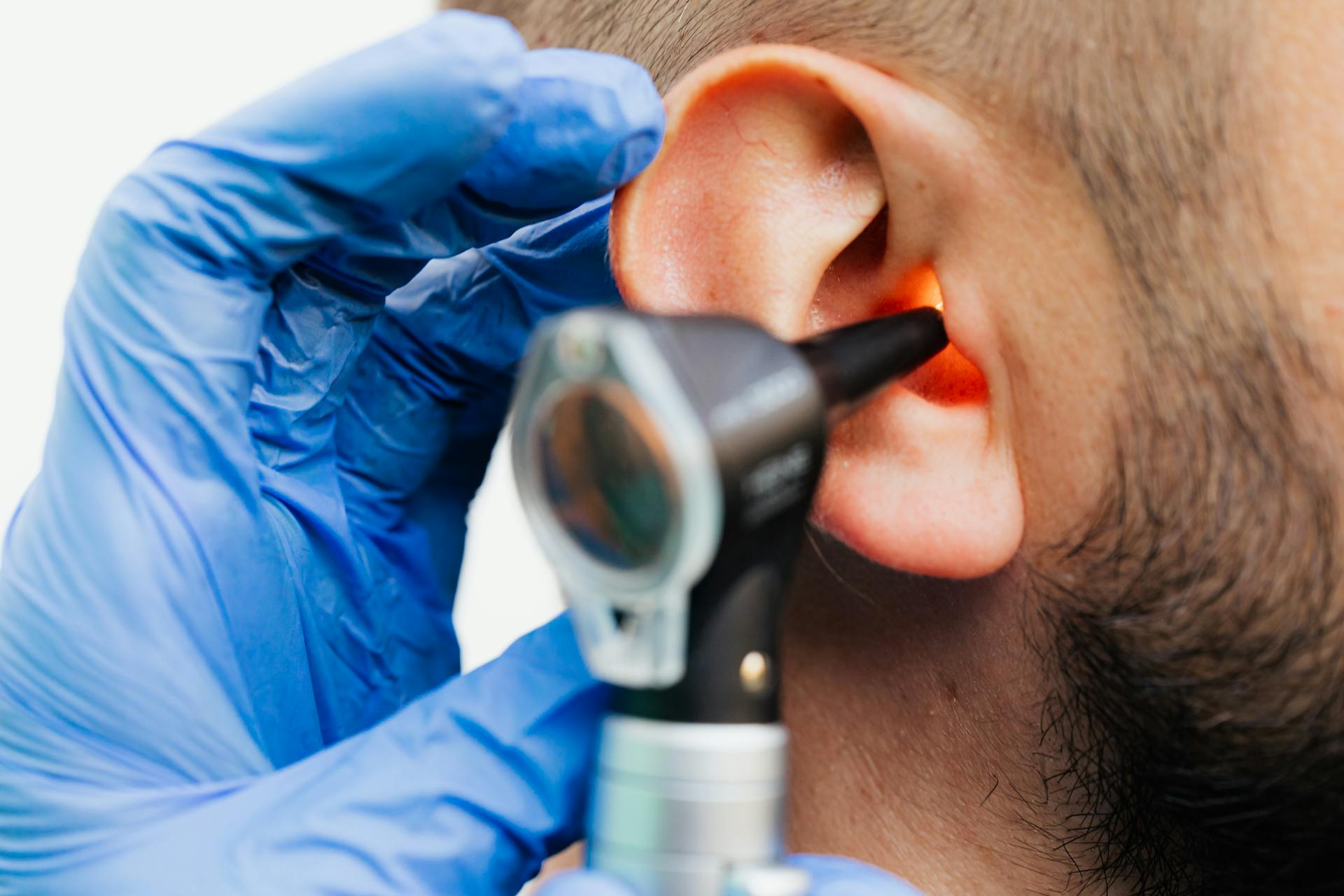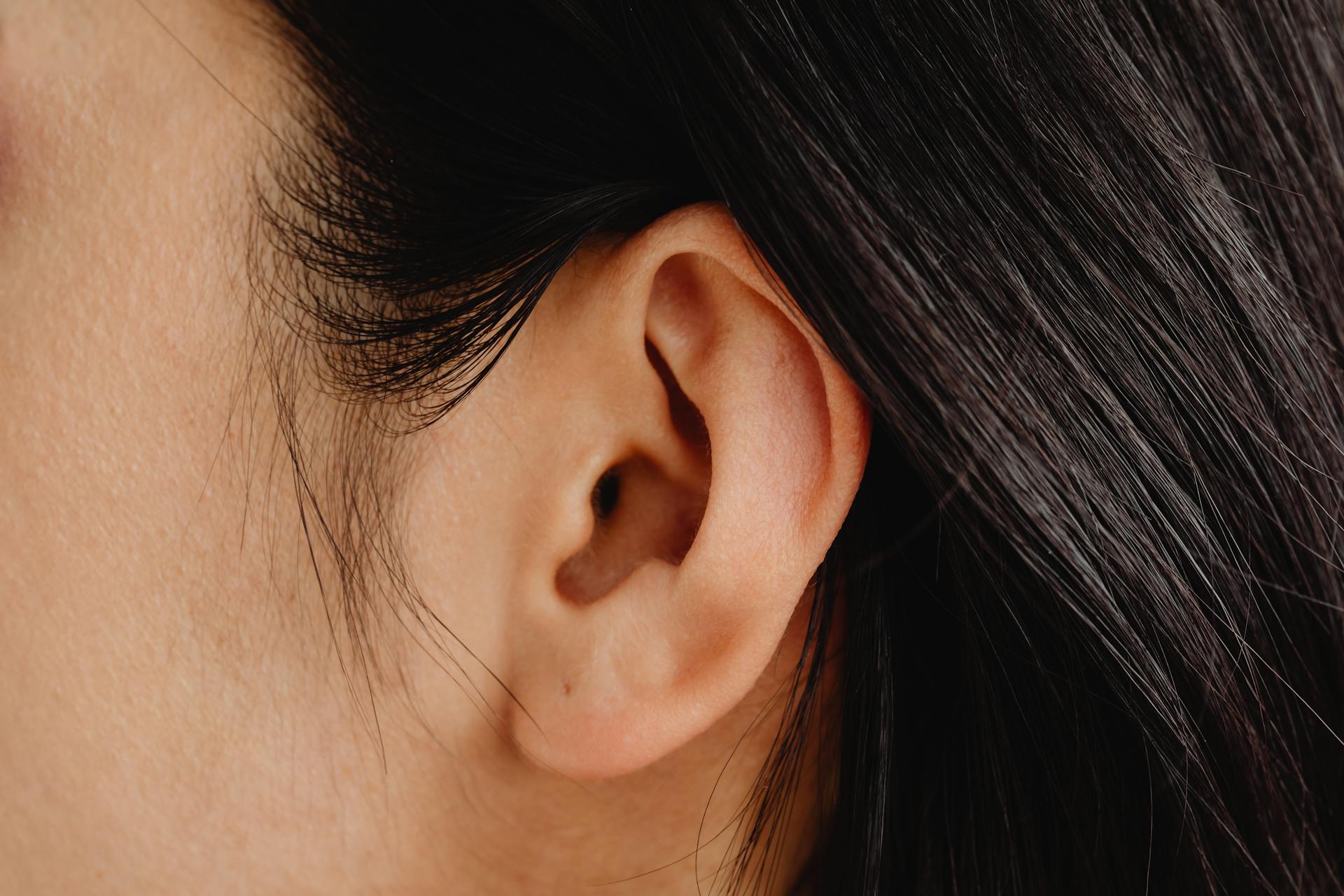
Taking care of your dog's ear health is crucial to prevent infections, pain, and even hearing loss.
Regular ear cleaning is essential, and it's best to use a veterinarian-recommended ear cleaner, not just any household product.
Dogs with floppy ears are more prone to ear infections due to moisture accumulation.
Ear infections can be painful for dogs, so it's essential to catch them early and seek veterinary attention.
Dogs that swim frequently are at a higher risk of developing ear infections due to water exposure.
Related reading: Ear Infections in Goldendoodles
Causes and Symptoms
Dogs can show no symptoms of ear infections aside from a buildup of wax and discharge in the ear canal. But ear infections often cause significant discomfort and affected dogs may show signs such as head shaking, scratching at the affected ear, dark discharge, odor, redness and swelling of the ear canal, pain, itchiness, and crusting or scabs in the ears.
A variety of painful symptoms can result from ear problems in dogs, including waxy or chunky debris in the ear canal, redness of the ear, foul or yeasty odor from the ear, excessive headshaking, and scratching at the ear.
See what others are reading: Foul Odor from Dog
Ear mites are a common cause of ear infections in dogs, and can lead to a range of symptoms including head shaking and head tilt, pain and discomfort, and a foul odor emitting from the ears. They can also cause aural hematoma (blood accumulation in the ear pinnae), discharge from the ear canals, and rubbing or pawing at the ears.
Here are some common symptoms of ear problems in dogs:
- Waxy or chunky debris in the ear canal
- Redness of the ear
- Foul or yeasty odor from the ear
- Excessive headshaking
- Scratching at the ear
- Yelping when the affected ear is touched
- A visible growth on or within the ear
- Wounds behind the ear from scratching
- Loss of fur or scaliness of the ear flap
- Swelling of the ear flap
- Loss of balance and coordination, rolling, or falling over
- Unintentional eye movement (nystagmus)
- Head tilt
Causes of Disease
Ear infections in dogs can be caused by a variety of underlying factors, including allergies, hypothyroidism, Cushing's Disease, and other endocrine disorders. These conditions can make your pet more susceptible to ear infections and are often responsible for repeated infections.
Ear mites, such as Demodex mites, can also cause ear infections in young puppies. They thrive on natural oils and ear wax, and can be especially problematic in young kittens.
Normal dog ears have a balance of bacteria and yeast, but when there's an overabundance of yeast or specific types of bacteria, an ear infection can develop. A swab of debris from the ear can be examined under a microscope to diagnose an ear infection.
For your interest: American Bully Ear Infection

Ear infections can cause permanent changes to the ear canal, such as thickening of the skin, which can narrow the canal and hinder a dog's hearing. In severe cases, ear infections can penetrate the eardrum and move into the middle or inner ear, resulting in balance issues for your dog.
Here are some common causes of ear infections in dogs:
- Allergies – both inhalant allergies (atopy) and food allergies
- Hypothyroidism, Cushing’s Disease, and other endocrine disorders
- Foreign material trapped deep in the ear canal or middle ear
- Ear mites (usually seen in young kittens)
- Resistant bacterial or yeast infections (often caused by the overuse of ineffective medications)
- Feline Leukemia (FeLV) and Feline Aids (FIV) infections in cats
- Autoimmune diseases including Lupus
Symptoms
Dogs can show a range of symptoms when they have an ear infection. Some dogs may not show any symptoms at all, but in many cases, you'll notice signs like head shaking, scratching at the affected ear, dark discharge, odor, and redness and swelling of the ear canal.
Head shaking is a common symptom of ear infections, as dogs try to relieve the discomfort in their ears. Scratching at the ear is also a common behavior, as the dog tries to alleviate the itchiness and pain.
A foul or yeasty odor from the ear is another sign of an ear infection. This is often accompanied by redness of the ear, which can be a sign that the infection is causing inflammation.
You might like: Why Is My Female Dog Scratching the Floor

Here are some common symptoms of ear infections in dogs:
- Head shaking
- Scratching at the ear
- Dark discharge
- Odor
- Redness and swelling of the ear canal
- Pain
- Itchiness
- Crusting or scabs in the ears
In some cases, ear infections can cause more severe symptoms, such as a visible growth on or within the ear, wounds behind the ear from scratching, loss of fur or scaliness of the ear flap, swelling of the ear flap, loss of balance and coordination, rolling, or falling over, and unintentional eye movement (nystagmus).
Diagnosis and Treatment
A precise diagnosis is crucial for treating dog ear infections. Your veterinarian will want to know the duration of symptoms, any allergies or underlying medical conditions, and what medications your dog is currently taking.
To diagnose an ear infection, your veterinarian will perform a physical examination, which may include a visual assessment, examination with an otoscope, and gentle palpation of the ear. In severe cases, your vet may recommend sedating your dog to facilitate examination deep within the ear canal.
A thorough history of the problem is essential for your veterinarian to understand the severity of the infection. This includes providing information about recent activities, such as baths, grooming, or swimming, and whether your dog has a history of ear infections.
Additional reading: Dog Ear Infection Packing
To confirm the diagnosis, your veterinarian may perform an ear swab to culture and sensitivity the discharge. This test can identify the specific bacteria and yeast present in the ear canal and determine which medications will be effective.
Treatment options for dog ear infections vary depending on the underlying cause. Your veterinarian may prescribe medicated ear cleansers, prescription ear drops, oral antibiotics, and anti-inflammatory medications.
In severe cases of chronic disease, your veterinarian may recommend surgery, such as a Total Ear Canal Ablation (TECA), to remove the ear canal and diseased tissue.
Here are the steps to follow for treating dog ear infections:
- Thoroughly clean your dog’s ears using a medicated ear cleanser.
- Prescribe prescription ear drops for you to use at home.
- Prescribe oral antibiotics and anti-inflammatory medications in severe cases.
- Follow your veterinarian’s instructions closely and return for recommended recheck appointments.
- Finish the full course of medication, even if your dog appears to be getting better.
Prevention and Care
Preventing ear infections in dogs is crucial, and it starts with regular ear cleaning. Excess moisture is a common cause, so thoroughly dry your dog's ears after swimming and bathing.
Ask your veterinarian about using a dog ear powder to help keep your dog's ears dry, especially if they're prone to chronic or recurrent ear infections. Identifying and managing underlying causes like allergies can also help prevent new infections.
A fresh viewpoint: Different Types of Dog Ear Infections
Cleaning your dog's ears at home can be a game-changer. Fill the canal with a dog ear cleaning solution, massage the vertical ear canal, and wipe it out with absorbent gauze. Avoid using paper towels or cotton, as they can leave fibers behind and cause irritation.
Don't forget to use dog ear cleaning wipes to clear away dirt and debris from the external ear flaps. And if your dog is showing signs of an ear infection, talk to your vet right away to seek treatment and prevent the problem from becoming serious.
Can You Prevent?
Preventing ear infections in dogs is a top priority for any dog owner. Excess moisture is a common cause of ear infections, so be sure to thoroughly dry your dog's ears after swimming and bathing.
You can also ask your veterinarian if a dog ear powder would be a good option for helping keep your dog's ears dry. Identifying and managing any underlying causes such as allergies can also help prevent new infections from occurring.

Cleaning your dog's ears at home can also help prevent ear infections. Fill the canal with a dog ear cleaning solution and massage the vertical ear canal from the outside, then wipe out the canal with absorbent gauze.
Don't use paper towels or cotton because these may leave fibers behind and cause irritation. You can also find dog ear cleaning wipes that are helpful for clearing away dirt and debris from the external ear flaps.
When to Contact Your Vet
If your dog is showing signs of ear discomfort or infection, it's essential to contact your veterinarian right away. Redness of the ear, a foul odor, or buildup of debris with redness are all warning signs that require professional attention.
Excessive scratching of the ear or pain when touched can also indicate a problem that needs to be addressed by a vet. Changes to your pup's balance may be a symptom of an ear infection that's affecting their equilibrium.
If your dog has a little debris in the ear, you might be tempted to clean it yourself, but it's best to err on the side of caution. If the debris is deep within the canal, it's best to seek a veterinarian's advice before attempting to clean the ear.
Explore further: Dog Ear Infection after Grooming
Common Issues
Dog ear infections can be caused by a wide range of irritants, pests, and germs that enter the ear canal, including ear mites, bacteria, allergens, and foreign matter.
Ear mites are a common culprit, using natural oils and ear wax as a food source and causing intense itching and discomfort for your pet.
A secondary infection can occur if the scratching breaks the skin, allowing bacteria to enter and creating more problems.
Here are the common symptoms of chronic ear infections in dogs:
- Head shaking and head tilt
- Pain and discomfort
- A foul odor emits from the ears
- Rubbing or pawing at the ears
- Aural hematoma (Blood accumulation in the ear pinnae)
- Discharge from the ear canals
Common Challenges
Ear problems are not uncommon in the pet community. Many animals' ears offer a relatively large passageway from the outside world into the ear canal, and ultimately to the delicate structures of the middle and inner ear.
Ear mites are a typical example of a common threat to dog ear health. These tiny creatures are almost invisible but can cause a great deal of trouble and discomfort for your pet.

Ear mites cause your pet to scratch or paw at the itchy ear continuously, which can lead to a painful, swollen hematoma of the ear flap.
Bacteria, allergens, or other foreign matter can also enter the ear directly, creating redness, swelling, itching, and pain.
Allergies can also play a role in ear problems, often leading to excessive ear wax production, which can cause an ear infection.
Here are some common ear problems in dogs:
- Foul odors from the ears
- Redness
- Debris buildup
- Other changes to the ear
These symptoms can be signs of a chronic ear infection, which can be caused by a variety of factors, including ear mites, bacteria, and allergies.
Dogs and Behavioral Issues
Dogs with certain medical conditions can develop behavioral issues due to their physical discomfort.
Dogs with ear infections, which are common in breeds like Basset Hounds, Chinese Shar-Pei, Labradoodles, Beagles, and Golden Retrievers, may exhibit behavioral changes such as whining, scratching, or shaking their heads.
Dogs with ear problems are more likely to become anxious or irritable due to the pain and discomfort associated with ear infections.
Some breeds, like Basset Hounds and Beagles, are more prone to ear infections due to their ear anatomy, which can lead to behavioral issues if left untreated.
A study found that 7.3% of dogs get ear infections yearly, highlighting the importance of regular ear checks and preventative care.
Breeds with a higher risk of ear infections include:
- Basset Hounds
- Chinese Shar-Pei
- Labradoodles
- Beagles
- Golden Retrievers
Frequently Asked Questions
How do you check a dog's ear health?
Check your dog's ears weekly, especially if they're prone to skin or ear issues, and lift the flap to inspect the inner ear for signs of infection or disease. Regular ear checks can help prevent problems and keep your dog's ears healthy and happy.
How do you tell if your dogs has an ear infection?
Look for signs like head shaking, redness, swelling, crusting, or a strong odor in your dog's ear, which can indicate an ear infection. If you notice any of these symptoms, it's essential to consult a veterinarian for proper diagnosis and treatment
Sources
- https://vcahospitals.com/know-your-pet/ear-infections-in-dogs-otitis-externa
- https://adobepetvet.com/services/ear-health-management
- https://www.akc.org/expert-advice/health/dog-ear-infections/
- https://www.petmd.com/dog/general-health/common-ear-problems-dogs-how-to-identify-diagnose-treat
- https://www.kingsdale.com/chronic-ear-infections-in-dogs-causes-and-treatments
Featured Images: pexels.com


